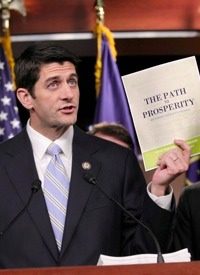
As noted elsewhere, Ryan’s plan would convert Medicaid into a block grant program, giving federal money to the states which would then design their own programs for providing healthcare services to the poor and disabled. It modifies Medicare into what Ryan calls a “premium-support” program whereby beneficiaries currently covered by Social Security age 55 and under would, upon reaching retirement age, be able to select their own coverage from a number of private insurers, which would be paid directly by the government for the coverage.
Nearly $1.4 trillion in savings would be generated from rescinding ObamaCare, while other savings would come from “reforming agricultural subsidies, shrinking the federal workforce through a sensible attrition policy, and accepting Defense Secretary Robert Gates’ plan to target inefficiencies at the Pentagon."
Federal job-training efforts would remain, but “dozens of duplicative job-training programs” would be consolidated "into more accessible, accountable career scholarships that will better serve people looking for work.”
In addition, Ryan’s plan would “end the conservatorship of Fannie Mae and Freddie Mac that is costing taxpayers hundreds of billions of dollars. ” And it would “roll back expensive handouts for uncompetitive sources of energy, calling instead for a free and open marketplace for energy development, innovation and exploration. ”
Ryan’s plan includes, as expected, overhauling the tax code by “consolidating brackets, lowering tax rates, and assuming top individual and corporate rates of 25%.” He claims such reforms to be “revenue-neutral,” which means that by eliminating various deductions and “loopholes,” revenue to the federal government would stay the same.
Ryan ends his op-ed piece with the usual Republican cheerleading:
This is America’s moment to advance a plan for prosperity. Our budget offers the nation a model of government that is guided by the timeless principles of the American idea: free-market democracy, open competition, a robust private sector bound by rules of honesty and fairness, a secure safety net, and equal opportunity for all under a limited constitutional government of popular consent.
Liberal opponents were ready to start attacking Ryan’s proposal as if it curtailed government programs, though they must have been relieved that nothing of substance about the proper role of government was being offered. Becky Thiess of the liberal Economic Policy Institute said that Ryan’s reforms “are just a disguised way of cutting the programs, and that the result will be higher out-of-pocket costs for the poor and elderly. ” House Minority Leader Nancy Pelosi claimed that Ryan’s plan is heading the wrong way, that according to a recent CNN poll, “87 percent of respondents said they want to see federal funding increase or remain the same for Medicare.” John Irons, director at the left-leaning Economic Policy Institute, said that Ryan’s budget plan “is impressive in its ability to not only inflict maximum harm on the economy, but to concentrate that harm on those most in need. This will not only cost the economy hundreds of thousands (and perhaps millions) of jobs over the next five years, it will also destroy the social safety net and undermine policies that support the middle class. ”
Applauding Ryan’s plan was former Minnesota Governor Tim Pawlenty who said, “With over $14 trillion [of] debt already, we should not allow Washington’s big spenders to put us further in the hole. We must get our fiscal house in order with real spending cuts and with real structural reforms that stop the spending spree before it bankrupts our country. ”
Investors Business Daily (IBD) took issue with Ryan’s critics, calling them the real “extremists”:
But who’s the real extremist here? The one who recognizes that $10 trillion-plus in expected deficits over the next 10 years is a serious problem? Or those who insist there’s no budget program so bad that more spending and a massive tax hike on all Americans can’t fix it?
IBD concluded that Ryan’s plan, although a good start, was simply not enough: “Even if he cut $6 trillion, our national debt would still rise. Faced with $10 trillion in deficits, [this] is just a modest start. ”
Erick Erickson of RedState.com applauded Ryan’s efforts, but withheld his complete support. While Ryan’s plan “defunds Obamacare, reforms Medicare and Medicaid, restructures the budget process, [and] simplifies the tax code, [it also supposedly] balances the budget in 26 years” — "if and only if the Democrats agree to it. That will never happen." Erickson adds that Ryan’s budget should be “the plan we should end up with after negotiations, not the plan we should start with for negotiations. ”
No one seems to be interested in discussing whether cuts are being proposed for programs that should, under the Constitution, be abolished altogether. Ryan makes no attempt to end government funding of healthcare, and yet in his call to arms he still refers to the need for citizens to support this “equal opportunity for all under a limited constitutional government.” He doesn’t want the government to get out of funding Medicaid; he merely wants to change how the government controls the states in their management of it. He wants to “consolidate Fannie Mae and Freddie Mac,” not sell them off. He wants to “roll back expensive handouts for uncompetitive sources of energy,” rather than eliminate those handouts altogether. He’s willing to give the Defense Department a pass on spending cuts, even though cuts could obviously be made in military spending without harming national security if the United States were to stop intervening in foreign quarrels and adopt a noninterventionist foreign policy. He continues to support the role of the federal government in providing job training and scholarship programs. He’s willing to let the number of federal government workers decline through attrition without a word about whether the agencies they work for are legal under the Constitution. No mention is made of abolishing the most obvious of those tyrannical agencies, such as the EPA, the TSA, the Commerce Department, the Department of Energy, or the Department of Education.
The $6.2 trillion in spending cuts Ryan is proposing over 10 years may sound like a gargantuan amount of money, but let us not forget that those cuts are based on changing projected future spending in the Obama budget, and that this is not the same thing as reducing spending in the absolute sense. Moreover, government indebtedness will continue to grow under the Ryan plan, for the simple reason that the currently projected $1 trillion-plus annual deficits — which are added to the total debt — cannot be eliminated by cutting an average of $620 billion per year.
The biggest disappointment is the one citizens should have expected from Ryan and the GOP: the budget is (successfully, so far) controlling the conversation about who gets how much of the pie and in what form, without any discussion whatsoever about shrinking the pie itself or questioning the proper role of government in slicing up the pieces in the first place.
Photo of Rep. Paul Ryan holding his budget proposal: AP Images



